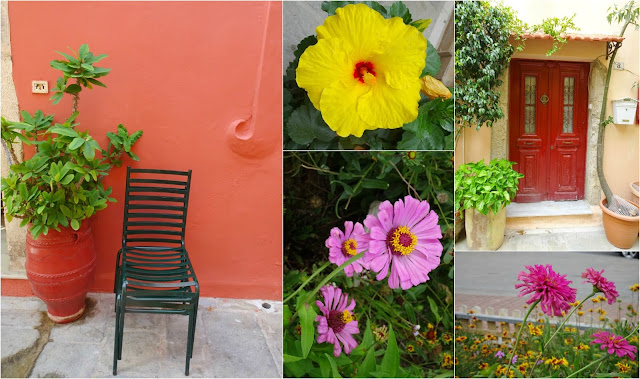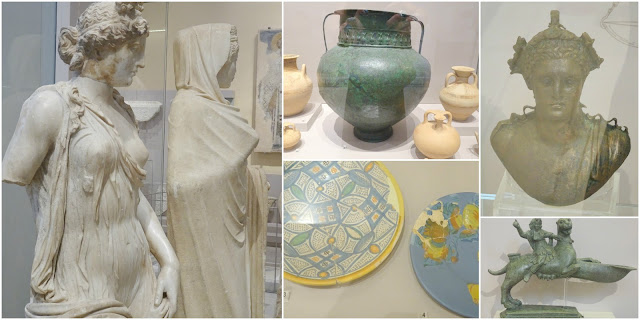What a welcome! Thank you so much for your lovely comments and messages, you certainly helped lift our post-trip, quarantine blues.
Ready for the next installment?
From Chania we caught the bus to Rethmyno, the first time I'd used public transport in six months (longer for Jon, he hadn't been on a bus since India). The bus runs every half-an-hour, costs €8.50 and the 65 km journey takes just over an hour. In Greece masks are mandatory for all passengers over 5 years of age. A masked conductor patrolled the aisle throughout the journey to ensure the rules were being followed. We've read that it's not uncommon for the police to stop buses and to do spot checks, throwing non-mask wearers off and issuing fines. Everyone abided by the rules, there doesn't seem as many Covidiots in Greece as there are at home.
Rethmyno is the island's cultural and intellectual capital, a relaxed university town overlooked by an imposing Venetian fortress, nestled in the foothills of Psiloritis, Crete's highest mountain.
Our home for the next three nights was this bougainvillea-covered apartment above a potter's studio. With the amount of cameras trained on us every time we sat out on the balcony we started to feel like superstars although I'm pretty such the tourists were more interested in the flora than the inhabitants.
Despite being Crete's third largest city, like Chania, Rethymno is an easy-going and laid back place with an old town packed with generations of fascinating Venetian and Turkish architecture, pretty much indistinguishable from one another. Ornate wooden doors, balconies and ancient stonework crop up everywhere with a number of mosques and elaborate Turkish fountains hidden in obscure corners.
Show me a dilapidated doorway and I'm a happy woman.
Rethymno is in a different prefecture to Chania. While mask wearing remains mandatory indoors, at entertainment venues and on public transport, you don't need to wear them in the street.
The seventeenth century Rimondi Fountain is a Venetian survivor with its lion head spouts looking over Platia Petihaki, in normal times said to be the liveliest part of town. Rethymno was pretty quiet during our visit although a couple of the coffee bars did get crowded at night (we gave them a wide berth)
Towering above our apartment was the ruins of the Fortezza, a huge Venetian fortress, large enough to shelter the entire population of Rethmyno in the event of a raid.
Said to be the largest Venetian castle ever built, the Fortezza was a response in the last quarter of the Sixteenth Century to a series of pirate raids (by Barbarossa in 1538 and Uluch Ali in 1562 and 1571) that had devastated the town. The Italian-designed fort took ten years to build but, in 1645, fell to the Turks in less than 24 hours.
When the English writer Robert Pashley visited in 1834 he found the guns, many Venetian originals, to be entirely useless.
Through the impressive gateway you emerge into a vast interior space dotted with the remains of barracks, arsenals, officers' houses, earthworks and deep shafts. At the centre is a large domed building which was once a church and later, following the fall of the town to the Turks, converted to a mosque dedicated to the ruler, Ibrahim.
I'm not sure how busy the Fortezza normally is but when we visited we shared it with two other couples, perfect for taking photos.
When we'd checked into our rooms our host, Frosso, warned us that Medicane, a tropical cyclone was on the way and severe weather warnings had been issued for the next 48 hours. Apparently high winds aren't a common occurrence in Rethmyno so I needed my hat to keep my hair from blinding me.
Although Medicane wrought havoc, washing roads away and destroying villages on the Greek mainland and causing the evacuation of tourists in Zante and Cephalonia, Crete was mercifully spared. We had hours of torrential rain and the mother of all electrical storms but luckily it was throughout the night and didn't curtail our activities (other than our sleep).
Rethymno's Archaeological Museum occupies the church of St Francis, once part of a Venetian monastery.
The gorgeous Venetian gateway behind is decorated the lions, the symbol of Venetian rule.
The collection within in the museum is staggering, ranging from Bronze Age axeheads over 100,000 years old to jewellery, amphora and pottery dating from as far back as 4000 BC, all found within the province of Rethmyno.
Helpfully each exhibit bore the image of a camera, with a red cross through any that couldn't be photographed.
The Rough Guide had warned us that Rethmyno's beaches would be packed and best avoided at weekends. On the Sunday we visited we had the entire place to ourselves and were able to enjoy our hastily gathered picnic of crusty local bread, tzatziki, goat's cheese flavoured with thyme and a tomato as big as your head in absolute peace. Travel during a worldwide pandemic ain't all bad.
A kingfisher - a common sight in Goa, the first time I'd spotted one in Greece.
When Jon shared some photos of the graffiti in Platia Mikrasiaton, behind the Neratses mosque on a travel forum several people were saddened by it, we thought it was rather wonderful.
Look at that sky! We had a feeling that we hadn't seen the last of Medicane.
So what else did we do as well as exploring the maze-like streets of the old town, basking on the beach, climbing up to old fortresses & visiting museums and galleries? Stuff our faces, of course!
There was Greek salad and Cretan olives (obviously); Fava, mashed white beans drizzled with olive oil & thyme; Sagnaki, pan-fried cheese; Kolokuthopita, courgette and feta cheese pie; Dolmades, vine leaves stuffed with lemon scented rice; Gigantes Plaki, butter beans in a tomato & herb sauce; Tiropita, Feta cheese pies in filo pastry; Kolokuthopita, aubergine and cheese fritters. Jon had lamb gyros.
The Cretan hospitality is legendary. Every taverna we visited gave us free desserts (either cake, baklava or fresh fruit) as well as a small bottle of raki, to aid digestion. We even got free raki when we popped in for an iced coffee at 11am. No wonder the Cretans smile so much!
We made friends with loads of cats. If you're not a fan of felines don't visit Greece!
We admired how, no matter how tiny their outside space, the Cretan always manage to fill every inch with beautiful plants.
Just like our time in Chania, our three days in Rethymno absolutely fled. Where next? Stay tuned for the next installment of our holiday diaries.
Stay safe and see you soon!
(For all my Rethmyno photos click
HERE)



















